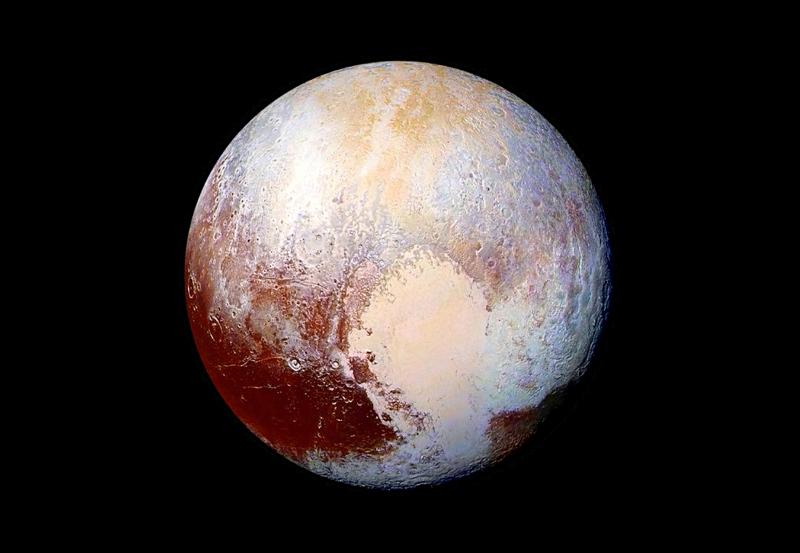Pluto, a frigid little world inhabiting the solar system’s outer reaches, may have been born as a warmer place sheltering a subsurface ocean that still exists today, researchers said on Monday. An analysis of images of its surface taken in 2015 by NASA’s New Horizons spacecraft and computer simulations of the dwarf planet’s interior led the researchers to propose a “hot start” scenario for Pluto’s formation some 4.5 billion years ago as the solar system, including Earth, took shape.
“When Pluto was forming, new material would have been coming in and impacting its surface. Each impact is like an explosion that would warm the nearby area,” said University of California Santa Cruz planetary scientist Carver Bierson, lead author of the research published in the journal Nature Geoscience.
“If Pluto formed slowly, the surface would cool between each impact and generally stay very cold. If Pluto formed quickly, you have impact on top of impact and the surface doesn’t have time to cool. We calculate that if Pluto formed in less than 30,000 years, the heat from these impacts could have been sufficient to lead to an early ocean,” Bierson added.

Photo: Reuters 照片:路透
Pluto, orbiting the sun about 40 times further than Earth in a region called the Kuiper Belt, may possess an icy outer shell hundreds of kilometers thick atop an ocean of water perhaps mixed with salts and ammonia, with a solid rocky core below, Bierson said. Under this scenario, parts of the ocean would gradually freeze over time. Water expands as it freezes, and cracks on Pluto’s surfacing may be evidence of this. Pluto’s surface temperature is about -230°C.
Because water is considered a vital ingredient for life, a subsurface ocean could make Pluto a long-shot candidate for harboring living organisms. “Water could have been interacting chemically with the rocky core beneath the ocean, giving you more chemical ingredients to work with,” Bierson added. “Are those the right ingredients for life? We don’t know. We need to learn more about how life forms, or how life could form, to find these answers.”
(Reuters)
科學家於週一指出,冥王星──這顆居住在太陽系外緣的小型嚴寒星體──在誕生時很可能是一個溫暖的地方,保護著一片今日仍然存在的地底海洋。研究人員分析了美國國家航空暨太空總署「新視野號」太空船在二○一五年拍下的冥王星表面影像,並利用電腦模擬這顆矮行星內部。他們提出假說,指出冥王星可能是在一個炙熱的情境中形成,當時距今約四十五億年,也就是包含地球在內的太陽系逐步成形的時代。
該研究的主要作者、美國加州大學聖塔克魯斯分校的行星科學家卡弗‧比爾森指出:「在冥王星形成初期,新的物質很可能持續不斷撞擊行星表面。每一次撞擊都像是一場爆炸,使得附近區域溫度升高。」這篇研究日前發表於《自然地球科學》期刊。
比爾森補充表示:「如果冥王星形成過程緩慢,表面就會在每次撞擊之間的空檔冷卻下來,大多數時間維持在相當低的溫度。假設這顆星球快速形成,撞擊一次接著一次,表面就會來不及冷卻下來。根據我們的計算,要是冥王星的形成時間少於三萬年,這些撞擊產生的高溫可能足以創造出一片早期海洋。」
冥王星在太陽系外圍稱作「古柏帶」的區域繞著太陽運行,與日距離約為地球的四十倍。比爾森指出,這顆行星可能擁有一塊厚達好幾百公里的結冰外殼,底下藏著一片液態海洋,水中可能混合著鹽類和氨,中間是一顆堅硬的岩石核心。在這樣的情境下,冥王星地底海洋的部分區域會隨著時間經過逐漸結冰。由於水在結冰時會膨脹,冥王星表面的裂痕可能就是地底海洋結冰推擠地殼的證據。該星球的表面溫度約為攝氏零下兩百三十度。
水被認為是構成生命的一項重要成分,因此地底海洋可能會讓冥王星成為有望庇護生命有機體的候選人之一,儘管此可能性相當渺茫。「水有可能和海洋底下的岩石核心不斷進行化學反應,製造出更多需要研究的化學成分,」比爾森補充表示:「那些是生命所需的正確成分嗎?我們不知道。科學家必須更深入研究生命如何形成,或是在什麼條件下才可能出現,進而找到這些問題的解答。」
(台北時報章厚明譯)

A: The National Palace Museum (NPM) has launched an exhibition, titled “From Impressionism to Early Modernism.” There are 81 masterpieces from the Metropolitan Museum of Art on display now. B: The exhibit, held to celebrate the NPM’s centennial, must be so spectacular. A: It includes artworks by 38 artists, such as Renoir, van Gogh, Cezanne, Matisse and Gauguin. B: The Fubon Art Museum has also launched an exhibit featuring a number of artworks of Impressionism, including Monet’s “Water Lilies.” A: And the New Taipei City Art Museum just had its grand opening, so there are even more exhibitions

A: What exhibitions are you going to see this summer? B: The 100% Doraemon & Friends exhibit is set to open on June 28. A: The news says there will be a 12-meter-tall giant Doraemon model at the Huashan 1914 Creative Park. B: The One Piece Carnival will set sail on the same day. A: And the D’festa Taipei 2025 – featuring exclusive content from K-pop supergroups such as BTS, NCT and Twice – is also set to begin next Friday. Isn’t that cool? A: 今年夏天還有什麼展覽可看啊? B: 「100%哆啦A夢 & Friends特展」即將在6月28日開幕。 A: 新聞說在華山1914文創園區會場,還有12米高的巨型哆啦A夢呢! B: 航海王「One Piece歡樂派對嘉年華」也將在同日啟航。 A:

The new generation born between 2025 and 2039 has been officially named “Generation Beta,” or simply “Gen Beta.” This generation will be the first to experience a world where artificial intelligence (AI) plays a key role in daily life. Generations are defined by shared cultural, social and historical experiences within a specific time frame. These experiences, often influenced by significant events and technological advancements, shape the values, attitudes and behaviors of each generation. The concept of generations helps us understand how different age groups interact with their environment and contribute to societal changes over time. The previous generational transition from Gen

Continued from yesterday(延續自昨日) https://www.taipeitimes.com/News/lang As Gen Beta grows, they are expected to witness advanced technologies becoming fully integrated into various fields like education, workplaces, healthcare and entertainment. In addition to technological developments, they will also face big challenges like severe climate change. Influenced by their Gen Y or Gen Z parents, who view climate change as a critical issue for the future and prioritize sustainability, they are likely to focus more on global issues and seek innovative solutions to address them. Moreover, Gen Beta will experience considerable demographic changes, such as lower birth rates and longer lifespans. Consequently, Gen Beta is predicted to